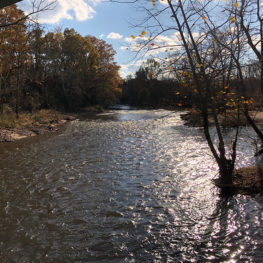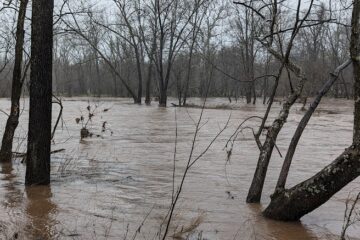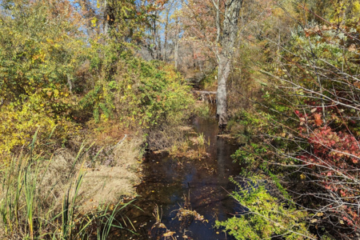
After removal of the dam
The outdoor clothing company Patagonia has awarded Raritan Headwaters Association (RHA) a $10,000 grant to help with the cost of removing a dam on the Lamington River, restoring the river’s flood plain and monitoring the ecological results.
The deteriorating Burnt Mills dam was taken down last fall, improving habitat for fish and other aquatic creatures. The project will continue this spring with flood plain restoration, including the planting of willow trees along the riverbank near Milnor Road.
“Removing the dam improves habitat for fish and other aquatic creatures,” said Cindy Ehrenclou, executive director of the Bedminster-based watershed watchdog. “We’re very grateful to Patagonia for supporting our efforts to improve the health of the Lamington River.”
Patagonia awards grants to nonprofits for projects such as improving wildlife habitat, creating trails and alleviating environmental problems.
“We are most interested in making corporate grants to organizations that identify and work on the root causes of problems and approach issues with a commitment to long-term change,” according to Patagonia’s website. “We look for innovative groups with proposed projects that are quantifiable, with specific goals, objectives and action plans, and that include measures for evaluating success.”
The old Burnt Mills dam – a remnant from an 1800s grist mill – accumulated river sediment, creating unhealthy conditions for most aquatic wildlife. In addition, the shallow pooled water behind the dam heated up in summer, depleting oxygen levels. Most aquatic life needs cool, clear, oxygen-rich water.
Removing the concrete dam allows free passage of migrating fish. The project also added riffles and pools to the river to improve fish habitat.
As part of the dam removal, the river was realigned to its historical configuration to reduce erosion and flooding in the Milnor Road-Cowperthwaite Road neighborhood, including an 11-acre nature preserve owned by Raritan Headwaters.
The Patagonia grant provides funding for RHA’s monitoring of the dam removal and stream restoration project. Grant funds will cover the costs of creating and implementing a three-year stream monitoring project, including training, equipment, lab costs, volunteer management, data management, analysis and a final report.
The dam project was done by Raritan Headwaters in partnership with the U.S. Department of Agriculture’s Natural Resources Conservation Service (NRCS) and the U.S. Fish and Wildlife Service.
About Raritan Headwaters
Raritan Headwaters has been working since 1959 to protect, preserve and improve water quality and other natural resources of the Raritan River headwaters region through science, education, advocacy, land preservation and stewardship. RHA’s 470-square-mile region provides clean drinking water to 300,000 residents of 38 municipalities in Somerset, Hunterdon and Morris counties and beyond to some 1.5 million homes and businesses in New Jersey’s densely populated urban areas.
To learn more about Raritan Headwaters and its programs, please visit www.raritanheadwaters.org or call 908-234-1852.



